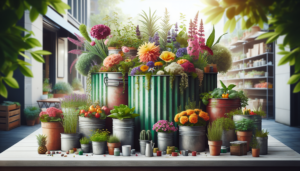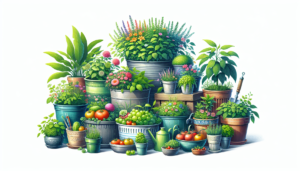
If you’re looking to create a beautiful garden in Alabama, but lack the space or access to traditional gardening methods, container gardening might just be the solution for you. Whether you have a small balcony, limited yard space, or simply want a more flexible gardening option, container gardening allows you to grow a variety of plants in a portable and manageable way. In this article, we will provide you with some helpful tips and tricks to ensure successful container gardening in Alabama, allowing you to enjoy the beauty of nature right at your fingertips.
Choosing Containers
When it comes to container gardening, the first step is to choose the right containers. Consider the size of the plants you want to grow and make sure the containers you choose are spacious enough to accommodate their root systems. Plants need room to grow and thrive, so be sure to select containers that are deep and wide enough for their needs.
Next, think about the materials of the containers. You can choose from a variety of options such as plastic, clay, or wood. Each material has its own advantages and disadvantages. Plastic containers are lightweight and affordable, while clay pots are porous and allow for better airflow. Wooden containers are durable and can add a rustic charm to your garden. Consider your specific needs and preferences when selecting the materials for your containers.
Proper drainage is crucial for the health of your plants. Make sure your containers have drainage holes at the bottom to prevent water from pooling and causing root rot. If you can’t find containers with pre-drilled holes, you can always create them yourself with a drill. Additionally, consider adding a layer of gravel or broken pottery at the bottom of the containers to improve drainage.
Choosing the Right Soil
The success of your container gardening endeavors depends largely on the quality of the soil you use. Before selecting a potting mix, it’s important to understand the local climate in Alabama. Consider the average rainfall and temperature patterns, as well as the specific needs of the plants you intend to grow.
Select a potting mix that is specifically formulated for container gardening. These mixes are often well-draining and provide the necessary nutrients for healthy plant growth. Avoid using garden soil in containers, as it tends to become compacted and doesn’t drain well in containers.
Consider adding organic matter, such as compost or aged manure, to your potting mix. Organic matter improves soil fertility, drainage, and moisture retention. It also adds beneficial microorganisms that help break down organic matter and release nutrients for the plants.
Selecting Suitable Plants
Choosing the right plants for your container garden is essential for successful gardening in Alabama. Research plant hardiness to ensure that the plants you select can tolerate the local climate and temperature extremes. Some plants may be more susceptible to heat or cold, so it’s important to choose varieties that are adapted to the Alabama climate.
In Alabama’s hot and humid summers, it’s important to choose heat-tolerant plant varieties. Look for plants that have been bred to withstand high temperatures and humidity. These plants will have a better chance of thriving in the Alabama climate.
Consider incorporating Alabama native plants into your container garden. Native plants are well-adapted to the local environment and require less maintenance. They also provide habitat and food for native wildlife, contributing to a healthier ecosystem.
Providing Adequate Sunlight
Sunlight is an essential factor in the growth and development of plants. Identify the amount of sunlight your chosen plants require and select a suitable location for your containers. Most plants need at least 6-8 hours of direct sunlight per day, but some may require more or less depending on their specific needs.
Consider the direction of light in your outdoor space. South-facing areas often receive the most sunlight, while north-facing areas tend to be shadier. East-facing and west-facing areas receive a mixture of direct and indirect sunlight throughout the day. Take note of the sun patterns in your garden to determine the best placement for your containers.
If you have plants that prefer partial shade or need protection from intense sunlight during the hottest part of the day, consider using shade cloth. Shade cloth can be easily attached to structures or placed over your containers to provide the necessary shade and protect delicate plants from sunburn and heat stress.
Watering Techniques
Watering your container plants properly is crucial for their health and success. Learn the specific water needs of the plants you are growing and adjust your watering routine accordingly. Some plants prefer consistently moist soil, while others prefer to dry out slightly between waterings. Understanding these needs will help prevent overwatering or underwatering.
Consider the material of your containers when determining your watering routine. Clay pots tend to dry out faster than plastic or wooden containers, requiring more frequent watering. Plastic and wooden containers retain moisture better and may require less frequent watering. Monitor the moisture level of the soil regularly and adjust your watering schedule accordingly.
Self-watering containers can also be a great option for container gardening in Alabama. These containers have a built-in water reservoir that allows plants to take up water as needed. They provide a consistent water supply and help prevent overwatering or underwatering.
Fertilizer and Nutrient Management
Proper fertilization is essential for container plants to thrive. Choose appropriate fertilizers based on the specific nutrient needs of your plants. Nitrogen, phosphorus, and potassium are the primary macronutrients that plants require. Look for fertilizers with balanced NPK ratios to ensure your plants receive the necessary nutrients for healthy growth.
Consider using slow-release fertilizers for container gardening. These fertilizers release nutrients gradually over time, providing a steady supply of essential elements for your plants. Slow-release fertilizers reduce the risk of nutrient runoff and help promote more even plant growth.
Monitor the nutrient levels in your container soil regularly. Over time, nutrients may become depleted, and adjustments may be needed. Conduct soil tests periodically to determine if any specific nutrients are lacking or imbalanced. Adjust your fertilization routine accordingly to provide the necessary nutrients for your plants.
Pest and Disease Control
Pests and diseases can be a challenge in any garden, but by implementing preventive measures, you can minimize damage and maintain healthy container plants. Identify common pests in Alabama, such as aphids, whiteflies, and spider mites, and keep an eye out for signs of infestation. Regularly inspect your plants for any unusual spots, holes, or damage caused by pests.
Implement preventive pest control measures to discourage pests from attacking your plants. This can include using organic insecticides, such as neem oil or insecticidal soap, to treat and prevent pest infestations. Additionally, practicing good sanitation, such as removing fallen leaves and plant debris, can help reduce pest populations.
Address diseases promptly to prevent their spread and save affected plants. Common diseases in Alabama include powdery mildew, root rot, and bacterial leaf spot. Fungicides and appropriate cultural practices, such as providing good airflow and avoiding overwatering, can help prevent and treat plant diseases.
Maintaining Container Health
Regular monitoring of plant growth is essential for maintaining container health. Keep an eye on the size and appearance of your plants to ensure they are growing properly. Prune and trim plants as needed to maintain their shape and prevent overcrowding. This will also promote airflow and reduce the risk of diseases.
Inspect your containers regularly for any signs of damage or wear. Look for cracks, chips, or signs of deterioration in the material. Damaged containers can impair proper drainage and airflow, and may need to be replaced to maintain the health of your plants.
Overcoming Climate Challenges
Alabama’s climate can present challenges for container gardening. To protect your plants during extreme weather conditions, consider taking proactive measures. During heatwaves, provide shade and use mulch to conserve moisture and reduce stress on plants. Shield plants from strong winds and heavy rains to prevent damage.
When cold snaps hit, provide insulation for your container plants. Wrap containers with bubble wrap or burlap to protect the roots from freezing temperatures. Consider moving sensitive plants indoors or to a more sheltered location during particularly cold periods.
Creating microclimates in your garden can also help mitigate climate challenges. Use trellises, fences, or tall plants to provide windbreaks and create pockets of slightly different microclimates. These microclimates can offer slightly different temperature and moisture conditions, allowing for a greater variety of plants and increased gardening success.
Seasonal Care
To ensure successful container gardening throughout the year in Alabama, adjust your gardening practices for different seasons. Plan for hot summers by choosing heat-tolerant plants and providing shade as needed. Water more frequently during dry spells to prevent drought stress.
Mild winters in Alabama still require some preparation. Protect your plants from freezing temperatures by covering them with blankets or moving them to a sheltered area during frost events. Consider using frost cloth, which provides insulation while still allowing light to penetrate.
During extreme weather conditions, such as prolonged heatwaves or severe frost, indoor gardening can be a viable option. Bring your containers indoors and place them near windows with sufficient sunlight. This allows you to continue gardening and protect your plants from extreme weather.
By following these tips for successful container gardening in Alabama, you can create a thriving garden that brings beauty and enjoyment year-round. Container gardening is a versatile and rewarding way to grow plants, even in challenging climates like Alabama. Get started today and experience the joys of gardening right outside your door.







